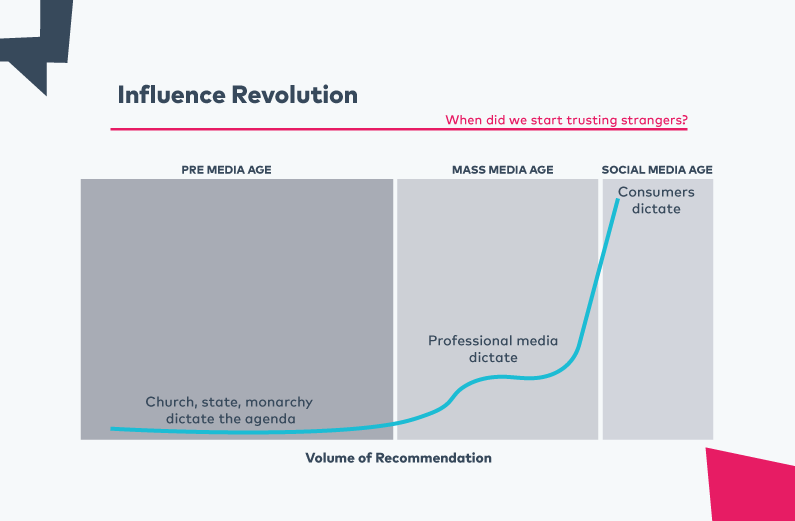Where did we set off from and where are we going?
People communicate: constantly, since forever, and in different ways. Brain growth enabled us to advance as a species and to beat other, faster and stronger species in the evolutionary race. Brain growth and communication are in a causal relationship. Using hands as work tools, but also means of communication has spurred brain growth and let humankind win over the place it holds today.
Why an article that observes human communication starting from the earliest days on a website of an agency that handles its most modern forms? If we don’t know where we set off from, we will struggle to see where we are going. So, let yourself go and enjoy the journey.
The evolution of communication
Communication, in its essence, represents a transfer of ideas, opinions, reasoning, thoughts, and electrical impulses from the mind of one person to the other. However simplified and reduced to metaphysics this notion may seem, it’s important because the future of communication will depend on the very capabilities that technology bestowed upon us, allowing us to exchange thoughts, almost without any intermediaries.
Most of us, when thinking about communication, first evoke social media, websites, chat services, and all these forms of communication that we so extensively use today. Digital is certainly not the only way to communicate on a mass scale, so when we talk about business communication, we can also take into account the traditional means of mass communication, such as television and radio. Other options stand at the disposal of professionals and marketers— billboards, newspaper ads, and magazine articles. The possibilities abound. Over the course of evolution of humankind and our communication along with it, technological development was shaping how we would exchange ideas, views, and thoughts. Our own thoughts!
From voice…
Apart from facial expressions, hand gestures, head and body movements, the basic form of direct communication is through voice. In the best-case scenario, the voice is heard at a few hundred meters, and facial expression is noticed at a shorter distance. As you can see in the graph 1, this is the way we have communicated most often, during the longest period of the progress of human civilization. “The times before the emergence of media” is the longest communication era that we know of and people communicated with each other individually or in masses. Only the privileged, rulers and gods had their representatives in communication. Rulers had messengers and gods had priests. One can say for them, partly joking and partly being serious that they were the first PRs.

Graphic 1: Overview of influence revolution. Source: Universal McCann
It’s not like our ancestors in those early stages of civilization development didn’t try to contrive in various ways and enhance the capacity and range of communication. As youngsters, many of us imitated Native Americans and sent smoke signals. And the birth of different alphabets and tools for their multiplication via transcription of materials has initiated a leap forward.
…to print media, radio, TV…
The key milestone on the path to mass communication took place in 1439 when Gutenberg invented the printing machine. Suddenly, we had an opportunity to reproduce a large number of copies based on one original sample. As a result, we ushered in the age when mass media would reign supreme, the “media era”. I will not bother with definitions of what media is or isn’t in this article, considering all the clashing of spears surrounding this topic. Besides, definitions aren’t of essential importance to this story. The point of it is that over time, technology advanced and increased the number of people who are able to share messages.
The time it takes for one tool of mass communication to really become massive has been shortening. For instance, it took radio 38 years to reach 50 million users. Television hit the same number of users after only 13 years, which is one-quarter of a century less time than radio needed. And when it appeared, the internet made it to 50 million users in just four years. When people get used to one technology, they adopt the next one easier, all while something new is already showing up on the horizon, something that will be the next step in the evolution of communication.
…to social media…
The era of mass media puts us in a position of mere consumers of the published content. The main characteristic of this kind of communication is that it’s one-way, curated, and dictated to the public by the media owner (and editor).
In the internet era, we’re in a situation where we can create content on our own and distribute it to the public. That is how we make our way to the “time of social media”, the time when the audience itself, thanks to the tech solutions, creates, publishes, comments on, and shares content. To put it simply, from passive consumers, we became active players on the media scene. The whole media picture is completed with the coexistence of owned, earned, and paid media, which the colleague Radukin actually wrote about at length. We are venturing into the “social media age”.
From those who communicate with conversational partners, dispatch a messenger or passively receive content via mass media, the audience has transformed into the one to set the pace for communication. This holds true whether it does that and creates content or actively comments, shares, and modifies it as per abilities that social media networks grant. Again, technological advancement upgrades communication. Today, we’re able to act as media outlets ourselves, to emit messages and connect with other people, sharing ideas and content with them.
As of lately, the term “social shopping” seems quite popular. It entails the refinement of social networks with the elements of stores. As analysis and experiences from the Far East (the region that has advanced the furthest here) confirm, separate locations, niche communities, or “vertical social media” that serve as a combination of communities and marketplaces will indeed develop. Nowadays, technology has turned the world into our oyster, and we can network exploring a myriad of possibilities.
And they proliferate literally from one day to the next.
…all the way to the chip
As technology develops further, communication will adapt to the new environment, sticking to humans as the foundation for any endeavor in the field and centering on their habits and needs. This is the only way for it to be successful!
Neuromancer, symbolically published in 1984, was the first novel from the Canadian futurist William Gibson in which the near future was portrayed. In many ways, that was the same time as the one we live in now. Gibson accurately predicted that people would be connected online, via a global computer network, something approximating Facebook today. He spoke of cyber terrorism and foretold digital wars. Thirty-five years later, Elon Musk launched his project for wiring electrodes into the brain. This project would open doors to what Gibson foresaw in his book, and precisely because of this, the author and a book are so relevant today.
What I’m certain of is that the very nature of communication will never change, regardless of whether two prehistoric men speak by the fireplace in a cave or whether we are connected with people around the globe through implants. What is crucial never to forget is that the starting point of communication; the one whom we address is always human. Everything else has to be adjusted and catered to it.
Only in this way can we be successful in the work we do!



